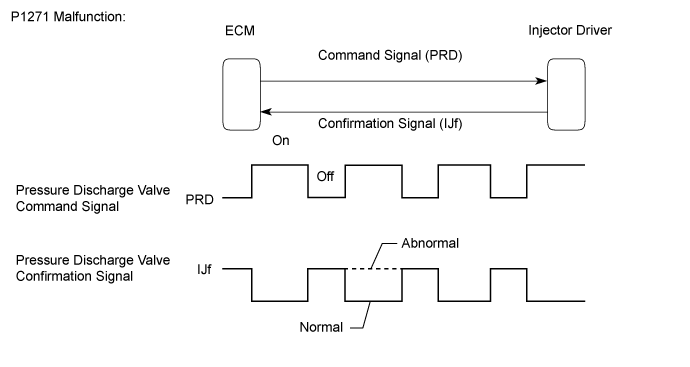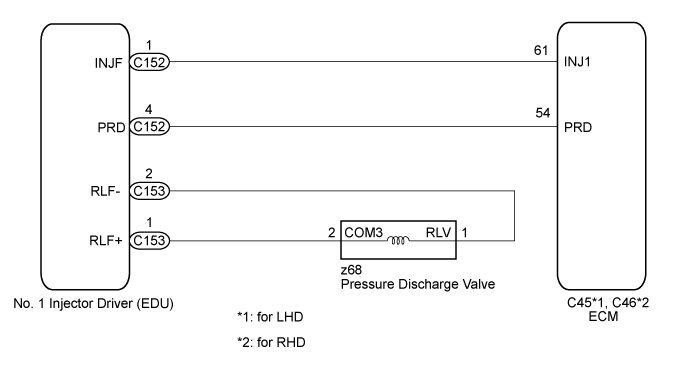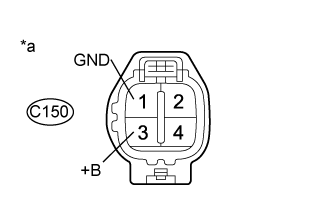Land Cruiser URJ200 URJ202 GRJ200 VDJ200 - 1VD-FTV ENGINE CONTROL
TYPICAL MALFUNCTION THRESHOLDS
PERFORM ACTIVE TEST USING GTS (PRESSURE DISCHARGE VALVE CHECK)
INSPECT COMMON RAIL ASSEMBLY (FOR BANK 2) (PRESSURE DISCHARGE VALVE RESISTANCE)
CHECK HARNESS AND CONNECTOR (PRESSURE DISCHARGE VALVE - NO. 1 INJECTOR DRIVER)
CHECK HARNESS AND CONNECTOR (NO. 1 INJECTOR DRIVER - ECM)
INSPECT NO. 1 INJECTOR DRIVER (POWER SOURCE CIRCUIT)
CHECK IF DTC OUTPUT RECURS (DTC P1271 OR P1272)
REPAIR OR REPLACE HARNESS OR CONNECTOR
REPLACE COMMON RAIL ASSEMBLY (FOR BANK 2) (PRESSURE DISCHARGE VALVE)
CONFIRM WHETHER MALFUNCTION HAS BEEN SUCCESSFULLY REPAIRED
DTC P1271 Fuel Regulator Circuit Malfunction (EDU Drive)
DTC P1272 Fuel Pressure Regulator Malfunction
DESCRIPTION
The ECM controls the internal fuel pressure of the common rail assembly by opening and closing the pressure discharge valve. When sudden deceleration occurs, the internal fuel pressure will temporarily become higher than usual and combustion noise may result. Therefore the ECM will open the valve temporarily to discharge the excess pressure inside the common rail assembly. Also, the pressure discharge valve opens when the engine switch is turned off to allow prompt discharge of the common rail internal pressure and so that the engine stops smoothly.
- HINT:


| DTC Detection Drive Pattern | DTC Detection Condition | Trouble Area |
| Engine switch on (IG) to OFF and Drive the vehicle at 50 km/h (31 mph) in third gear, and then decelerate by releasing the accelerator pedal | When either condition below is met a certain number of times (0.5 seconds) (1 trip detection logic): Open or short in pressure discharge valve circuit. There is no valve opening confirmation (IJf) signal from the injector driver to the ECM for a specific number of times consecutively despite the ECM sending valve opening command (PRD) signals after the engine is started. | Open or short in pressure discharge valve circuit Pressure discharge valve (common rail assembly (for bank 2)) No. 1 injector driver |
| DTC Detection Drive Pattern | DTC Detection Condition | Trouble Area |
| Engine switch on (IG) to OFF | Pressure discharge valve does not open. Actual pressure decreasing rate deviates from the simulated pressure decreasing rate after the ignition switch is turned off (2 trip detection logic). | Open or short in pressure discharge valve circuit (P1271 is stored simultaneously) Pressure discharge valve (common rail assembly (for bank 2)) No. 1 injector driver ECM |
| DTC No. | Data List |
| P1271 P1272 | Common Rail Pressure Target Common Rail Pressure Pressure Discharge Valve |
- HINT:
After clearing the DTC, drive the vehicle at 50 km/h (31 mph) in third gear, and then decelerate by releasing the accelerator pedal. Check that P1271 is not output.
After clearing the DTC, start and stop the engine twice (wait 30 seconds or more after turning the ignition switch off before starting the engine the second time), and then confirm that P1272 is not stored.
| Engine Speed | Common Rail Pressure (kPa) |
| Idling | Common Rail Pressure is within 5000 kPa of Target Common Rail Pressure |
| 2500 rpm (No engine load) |
| Condition | Common Rail Pressure (Idling) | Common Rail Pressure (1 Second after Engine Stopped) |
| Pressure discharge valve normal | 35000 kPa | 500 kPa |
| Open in pressure discharge valve circuit | 35000 kPa | 30000 kPa |
MONITOR DESCRIPTION
This DTC will be stored if there is no valve opening confirmation (IJf) signal sent from the injector driver to the ECM despite the ECM commanding the injector driver to open the pressure discharge valve. This DTC refers to an open or short circuit malfunction of the pressure discharge valve circuit, not a malfunction in which a valve is stuck open or closed.
The injector driver monitors the current supplied to the pressure discharge valve to verify that the current flows into the valve. If the current exceeds the specified level, the injector driver interprets this as the IJf signal being low. If this DTC is stored, the ECM enters fail-safe mode and limits engine power. The ECM continues operating in fail-safe mode until the engine switch is turned off.

The pressure discharge valve will open and discharge the internal fuel pressure from the common rail to the fuel tank when the engine switch is turned off. In this event, the ECM compares the actual drop rate of the internal fuel pressure and the target drop rate. If the ECM judges that the actual drop rate is smaller than the target, the ECM then determines that the valve is stuck closed and stores this DTC. This DTC will be stored if the internal fuel pressure does not drop to the target after the engine switch has been turned off.
If this DTC is stored, the ECM enters fail-safe mode and limits engine power. The ECM continues operating in fail-safe mode until the engine switch is turned off.
MONITOR STRATEGY
| Required sensors | Injector driver |
| Frequency of operation | Continuous |
| Duration | 3 seconds |
| MIL operation | 1 driving cycle |
| Required sensors | Fuel pressure sensor |
| Frequency of operation | Once per driving cycle |
| Duration | 1 second |
| MIL operation | 2 driving cycles |
TYPICAL ENABLING CONDITIONS
| Specification |
| The vehicle is driven at 50 km/h (31 mph) in 3rd gear, and then decelerated by complete release of the accelerator pedal 3 times. |
| Item | Specification | |
| Minimum | Maximum | |
| Common Rail Pressure | 30000 kPa (306 kgf/cm2, 4350 psi) | - |
| Fuel temperature | 0°C (32°F) | - |
| Battery voltage | 11 V | - |
| The monitor will not run if the fuel pressure sensor, pressure discharge valve circuit or fuel temperature sensor is malfunctioning. | ||
TYPICAL MALFUNCTION THRESHOLDS
| Specification |
| There are no confirmation signals from the injector driver for a specific number of times consecutively, despite the ECM sending command signals regularly during deceleration. |
| Specification |
| The internal pressure stays beyond the specified level after the engine switch is turned off. |
WIRING DIAGRAM

INSPECTION PROCEDURE
- NOTICE:
- HINT:
| 1.CHECK IF DTC OUTPUT RECURS |
Connect the GTS to the DLC3.
Clear the DTCs ().
Turn the engine switch off for 30 seconds or more.
Turn the engine switch on (IG).
Drive the vehicle at 50 km/h (31 mph) in 3rd gear, and then decelerate by completely releasing the accelerator pedal. Perform this 3 times.
Enter the following menus: Engine and ECT / Trouble Codes.
Read the pending DTCs.
| Result | Proceed to |
| P1272 is output | A |
| P1271 is output | B |
| P1271 and P1272 are output | B |
| Other DTCs are output | C |
|
| ||||
|
| ||||
| A | |
| 2.PERFORM ACTIVE TEST USING GTS (PRESSURE DISCHARGE VALVE CHECK) |
Connect the GTS to the DLC3.
Turn the engine switch on (IG).
Turn the GTS on.
Enter the following menus: Engine and ECT / Utility / Pressure Discharge Valve Check.
Select the check type for "Valve Check for Graph".
Press "Start" and perform "Pressure Discharge Valve Check".
- HINT:
- For more information about "Pressure Discharge Valve Check / Valve Check for Graph", refer to System Check ().
Check the engine speed and fuel pressure when the pressure discharge valve is turned from off to on.
- OK:
Pressure Discharge Valve OFF ON Engine Speed Idling: 550 to 650 rpm Changes to 0 rpm Fuel Pressure Idling: 27000 to 49000 kPa Changes to 0 kPa
- HINT:
- When the system is normal, the following changes will be displayed on the GTS.
|
| ||||
|
| ||||
| 3.INSPECT COMMON RAIL ASSEMBLY (FOR BANK 2) (PRESSURE DISCHARGE VALVE RESISTANCE) |
Inspect the common rail assembly (for bank 2) ().
|
| ||||
| OK | |
| 4.CHECK HARNESS AND CONNECTOR (PRESSURE DISCHARGE VALVE - NO. 1 INJECTOR DRIVER) |
Disconnect the No. 1 injector driver connector.
Disconnect the pressure discharge valve connector.
Measure the resistance according to the value(s) in the table below.
- Standard Resistance:
Tester Connection Condition Specified Condition z68-2 (COM3) - C153-2 (RLF+) Always Below 1 Ω z68-1 (RLV) - C153-1 (RLF-) Always Below 1 Ω z68-2 (COM3) or C153-2 (RLF+) - Body ground Always 10 kΩ or higher z68-1 (RLV) or C153-1 (RLF-) - Body ground Always 10 kΩ or higher
Reconnect the No.1 injector driver connector.
Reconnect the pressure discharge valve connector.
|
| ||||
| OK | |
| 5.CHECK HARNESS AND CONNECTOR (NO. 1 INJECTOR DRIVER - ECM) |
Disconnect the No. 1 injector driver connector.
Disconnect the ECM connector.
Measure the resistance according to the value(s) in the table below.
- Standard Resistance:
for LHD Tester Connection Condition Specified Condition C152-4 (PRD) - C45-54 (PRD) Always Below 1 Ω C152-1 (INJF) - C45-61 (INJ1) Always Below 1 Ω C152-4 (PRD) or C45-54 (PRD) - Body ground Always 10 kΩ or higher C152-1 (INJF) or C45-61 (INJ1) - Body ground Always 10 kΩ or higher for RHD Tester Connection Condition Specified Condition C152-4 (PRD) - C46-54 (PRD) Always Below 1 Ω C152-1 (INJF) - C46-61 (INJ1) Always Below 1 Ω C152-4 (PRD) or C46-54 (PRD) - Body ground Always 10 kΩ or higher C152-1 (INJF) or C46-61 (INJ1) - Body ground Always 10 kΩ or higher
Reconnect the No. 1 injector driver connector.
Reconnect the ECM connector.
|
| ||||
| OK | |
| 6.INSPECT NO. 1 INJECTOR DRIVER (POWER SOURCE CIRCUIT) |

Disconnect the No. 1 injector driver connector.
Measure the voltage according to the value(s) in the table below.
- Standard Voltage:
Tester Connection Switch Condition Specified Condition C150-3 (+B) - C150-1 (GND) Engine switch on (IG) 11 to 14 V
| *a | Front view of wire harness connector (to No. 1 injector Driver) |
Reconnect the No. 1 injector driver connector.
|
| ||||
| OK | |
| 7.REPLACE NO. 1 INJECTOR DRIVER |
Replace the No. 1 injector driver ().
| NEXT | |
| 8.CHECK IF DTC OUTPUT RECURS (DTC P1271 OR P1272) |
Connect the GTS to the DLC3.
Clear the DTCs ().
Turn the engine switch off for 30 seconds or more.
Turn the engine switch on (IG).
Drive the vehicle at 50 km/h (31 mph) in 3rd gear, and then decelerate by completely releasing the accelerator pedal. Perform this 3 times.
Enter the following menus: Engine and ECT / Trouble Codes.
Read the pending DTCs.
- HINT:
Enter the following menus: Engine and ECT / Utility / All Readiness.
Input DTC P1271 and P1272.
Check the DTC judgment result.
| GTS Display | Result | Proceed to |
| Pending DTC | P1271 or P1272 is output | B |
| All Readiness | NORMAL | A |
| ABNORMAL | B |
- HINT:
- If STATUS is INCOMPLETE or N/A, perform the following procedure 3 times: drive the vehicle at 50 km/h (31 mph) in 3rd gear, and then decelerate by completely releasing the accelerator pedal.
|
| ||||
| A | ||
| ||
| 9.REPAIR OR REPLACE HARNESS OR CONNECTOR |
Repair or replace the harness or connector.
|
| ||||
| 10.GO TO INJECTOR CIRCUIT |
Go to injector circuit ().
|
| ||||
| 11.REPLACE ECM |
Replace the ECM ().
|
| ||||
| 12.REPLACE COMMON RAIL ASSEMBLY (FOR BANK 2) (PRESSURE DISCHARGE VALVE) |
Replace the common rail assembly (for bank 2) ().
| NEXT | |
| 13.BLEED AIR FROM FUEL SYSTEM |
Bleed the air from the fuel system ().
Perform PM forced regeneration ().
- HINT:
- When fuel lines are disconnected, air may enter the fuel lines, leading to engine starting trouble. Therefore, perform forced regeneration and bleed the air from the fuel lines.
| NEXT | |
| 14.CONFIRM WHETHER MALFUNCTION HAS BEEN SUCCESSFULLY REPAIRED |
Connect the GTS to the DLC3.
Clear the DTCs ().
Turn the engine switch off for 30 seconds or more.
Turn the engine switch on (IG).
Drive the vehicle at 50 km/h (31 mph) in 3rd gear, and then decelerate by completely releasing the accelerator pedal. Perform this 3 times.
Enter the following menus: Engine and ECT / Trouble Codes.
Confirm that the pending DTC is not output again.
- HINT:
- Perform the following procedure using the GTS to determine whether or not the DTC judgment has been carried out.
Enter the following menus: Engine and ECT / Utility / All Readiness.
Input DTC P1271 and P1272.
Check the DTC judgment result.
- HINT:
- If STATUS is INCOMPLETE or N/A, perform the following procedure 3 times: drive the vehicle at 50 km/h (31 mph) in 3rd gear, and then decelerate by completely releasing the accelerator pedal.
| NEXT | ||
| ||
